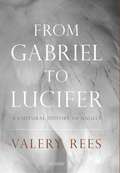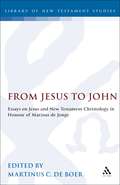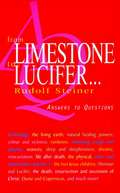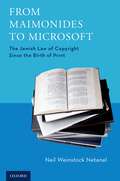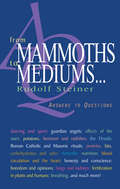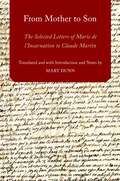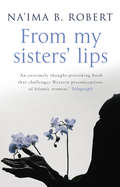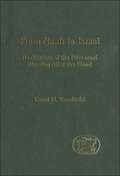- Table View
- List View
From Eucharistic Adoration to Evangelization
by Alcuin ReidA collection of essays and homilies from Pope Benedict, Cardinals and Bishops focusing on the relevance of Eucharistic adoration for liturgy, spirituality and mission today.
From Fatwa to Jihad: How the World Changed: The Satanic Verses to Charlie Hebdo
by Kenan MalikLonglisted for the Orwell Prize for Books 2010The Number 1 international bestseller updated and reissued.Almost thirty years ago, the image of burning copies of Salman Rushdie's The Satanic Verses held aloft by thousand-strong mobs of protesters became an internationally familiar symbol of anger and offence. In From Fatwa to Jihad, Kenan Malik reveals how the Rushdie affair transformed the debate worldwide on multiculturalism, tolerance and free speech, helped fuel the rise of radical Islam and pointed the way to the horrors of 9/11 and 7/7. In this new edition, Malik examines the rise of home-grown jihadis, the threat of IS-inspired terrorism in Europe and how the West has failed to learn the lessons of the past.
From Financial Crisis to Social Change: Towards Alternative Horizons
by Torsten Geelan Marcos González Hernando Peter William WalshThis edited collection critically engages with a range of contemporary issues in the aftermath of the North Atlantic financial crisis that began in 2007. From challenging the erosion of academic authority to the myth that parliamentary democracy is not worth engaging with, it addresses three interrelated questions facing young people today: how to reclaim our universities, how to revitalise our democracy and how to recast politics in the 21st century. This book emphasises the crucial importance of generational experience as a wellspring for progressive social change. For it is the young generations who have come of age in a world marred by crises that are at the forefront of challenging the status quo. With insight into new social movements and protests in the UK, Canada, Greece and Ukraine, this stimulating collection of works will be invaluable for those teaching, studying and campaigning for alternatives. It will also be of relevance to scholars in social movement studies, the sociology and anthropology of economic life, the sociology of education, social and political theory, and political sociology.
From Financial Crisis to Social Change: Towards Alternative Horizons
by Torsten Geelan Marcos González Hernando Peter William WalshThis edited collection critically engages with a range of contemporary issues in the aftermath of the North Atlantic financial crisis that began in 2007. From challenging the erosion of academic authority to the myth that parliamentary democracy is not worth engaging with, it addresses three interrelated questions facing young people today: how to reclaim our universities, how to revitalise our democracy and how to recast politics in the 21st century. This book emphasises the crucial importance of generational experience as a wellspring for progressive social change. For it is the young generations who have come of age in a world marred by crises that are at the forefront of challenging the status quo. With insight into new social movements and protests in the UK, Canada, Greece and Ukraine, this stimulating collection of works will be invaluable for those teaching, studying and campaigning for alternatives. It will also be of relevance to scholars in social movement studies, the sociology and anthropology of economic life, the sociology of education, social and political theory, and political sociology.
From Followers to Leaders: The Apostles in the Ritual Status Transformation in Acts 1-2 (The Library of New Testament Studies #255)
by Nelson P. EstradaNelson Estrada examines the apostles' transformation of status from followers to leaders in Acts 1-2. He challenges the common view that Acts 1:12-14 is the preparation for the coming of the Spirit in Acts 2, and that the sole purpose of Acts 1:15-26 is to set the number of the apostles at twelve-in line with Jesus' prophecy in Luke 22:30. Instead, Estrada reads Acts 1:12-14 and 1:15-26 as primarily propagandistic in nature. He argues that these pericopes promote the leadership integrity of the apostles by attempting to win the support of the women disciples and Jesus' family and then, through Judas' excommunication, extirpation, and replacement, to win that of the 120 disciples.
From Gabriel to Lucifer: A Cultural History of Angels
by Valery ReesFiery the angels fell; slow thunder rolled around their shores, burning with the fires of Orc.' Whether in recent popular culture, or back across countless centuries, angels have perpetually enthralled, mystified and even terrified us. 'Every single angel is terrible,' wrote the German Romantic poet Rilke: 'and so I hold myself back from the dark bird-cry of my anguished sobbing.' For some in the sceptical, post-Enlightenment West, angels may be no more than metaphors: poetic devices to convey, at least for those with a religious sensibility, an active divine interest in creation. But for others, angels are absolutely real beings: manifestations of cosmic power and energy with the capacity either to enlighten or annihilate those whose awestruck paths they cross.Valery Rees here offers the first comprehensive history of these beautiful, enigmatic and sometimes dangerous beings, whose existence and actions have been charted across the eons of time and civilizations. From the ancient Sumerian and Akkadian winged figures, to Egyptian representations of Ma'at, Persian genii, Arab djinn, biblical cherubim, daemons of Hermes Trismegistus and Milton's defiant fallen angels, From Gabriel to Lucifer reveals a mesmerising trajectory of angelic belief. Whether exploring the feverish visions of Ezekiel and biblical cherubim; the Islamic archangels Jibra'il, Azra'il, Mika'il and Israfil; the austere and haunting icons of Andrei Rublev; or Wim Wenders' Wings of Desire, and the more benign idea of the ever-watchful guardian angel, the author shows that the very ubiquity of these implacable celestial messengers reveal something fundamental, if not about God and the devil, then about ourselves: our perennial preoccupation withhow to depict the transcendent.
From Good Goddess to Vestal Virgins: Sex and Category in Roman Religion
by Ariadne StaplesThe role of women in Roman culture and society was a paradoxical one. On the one hand they enjoyed social, material and financial independence and on the other hand they were denied basic constitutional rights. Roman history is not short of powerful female figures, such as Agrippina and Livia, yet their power stemmed from their associations with great men and was not officially recognised.Ariadne Staples' book examines how women in Rome were perceived both by themselves and by men through women's participation in Roman religion, as Roman religious ritual provided the single public arena where women played a significant formal role. From Good Goddess to Vestal Virgins argues that the ritual roles played out by women were vital in defining them sexually and that these sexually defined categories spilled over into other aspects of Roman culture, including political activity.Ariadne Staples provides an arresting and original analysis of the role of women in Roman society, which challenges traditionally held views and provokes further questions.
From Good Goddess to Vestal Virgins: Sex and Category in Roman Religion
by Ariadne StaplesThe role of women in Roman culture and society was a paradoxical one. On the one hand they enjoyed social, material and financial independence and on the other hand they were denied basic constitutional rights. Roman history is not short of powerful female figures, such as Agrippina and Livia, yet their power stemmed from their associations with great men and was not officially recognised.Ariadne Staples' book examines how women in Rome were perceived both by themselves and by men through women's participation in Roman religion, as Roman religious ritual provided the single public arena where women played a significant formal role. From Good Goddess to Vestal Virgins argues that the ritual roles played out by women were vital in defining them sexually and that these sexually defined categories spilled over into other aspects of Roman culture, including political activity.Ariadne Staples provides an arresting and original analysis of the role of women in Roman society, which challenges traditionally held views and provokes further questions.
From Here to You (Crash and Burn #1)
by Jamie McGuireDiscover a new series from the author of the #1 New York Times bestseller Beautiful Disaster: a "heartbreaking and hopeful, raw and sexy" story about one woman's struggle to start over and the man determined to protect her at all costs. (Lauren Blakely, author of Part-Time Lover). Named one of the "Best Romance Books of 2018" by Bookbub! As Darby Dixon sits in a tiny Texas church bathroom on her wedding day holding a positive pregnancy test, she realizes that marrying her fiancé would be the worst decision of her life. She's never been very good at standing up for herself, but she'll sure as hell stand up for her baby. With very little cash and a ton of courage, she flees town to take a new name and start a new life.As a Marine, Scott "Trex" Trexler worked in the most treacherous, corrupt, war-torn places on earth. With his new top-secret security job, he finally has a chance to return to the one place he's felt at peace: Colorado Springs, Colorado.The moment Trex checks in at the hotel where she's working, Darby knows he's dangerous. He may want her to think he's another hotshot firefighter, along with all the others battling the nearby mountain blaze, but something doesn't add up. No way will she get involved with another man she can't fully trust - and Trex clearly isn't telling her everything. As Darby's ex gets closer and closer to finding her, both she and Trex will soon find out that what you don't know really can hurt you."This love story is raw, brilliant, and gives women hope in the impossible. Nothing is more precious than that." -- Audrey Carlan, #1 New York Times bestselling author"Jamie McGuire writes with no holds barred ... real and addictive." -- USA Today"Jamie McGuire is masterful at emotional romance!" -- Lauren Blakely, #1 New York Times bestselling author"Heartfelt emotions, serious social concerns and exceptional character development result in a touching modern romance with inspirational overtones; a sure winner." -- Library JournalWhat readers are saying about From Here to You..."Addicting!""I just totally cheated on Travis Maddox!""The best book Jamie has written!""Sexy, sweet, heartfelt, steamy, emotional, and suspenseful."
From Human to Posthuman: Christian Theology and Technology in a Postmodern World (Routledge Science and Religion Series)
by Brent WatersTechnology is one of the dominant forces shaping the emerging postmodern world. Indeed the very fabric of daily life is dependent upon various information, communication, and transportation technologies. With anticipated advances in biotechnology, artificial intelligence, and robotics, that dependence will increase. Yet this growing dependence is accompanied with a deep ambivalence. For many technology symbolises the faith of the postmodern world, but it is an ambivalent faith encapsulating both our hopes and fears for the future. This book examines the religious foundations underlying this troubled faith in technology, as well as critically and constructively engaging particular technological developments from a theological perspective.
From Human to Posthuman: Christian Theology and Technology in a Postmodern World (Routledge Science and Religion Series)
by Brent WatersTechnology is one of the dominant forces shaping the emerging postmodern world. Indeed the very fabric of daily life is dependent upon various information, communication, and transportation technologies. With anticipated advances in biotechnology, artificial intelligence, and robotics, that dependence will increase. Yet this growing dependence is accompanied with a deep ambivalence. For many technology symbolises the faith of the postmodern world, but it is an ambivalent faith encapsulating both our hopes and fears for the future. This book examines the religious foundations underlying this troubled faith in technology, as well as critically and constructively engaging particular technological developments from a theological perspective.
From Jesus to John: Essays on Jesus and New Testament Christology in Honour of Marinus de Jonge (The Library of New Testament Studies #84)
by Martinus C. de BoerMarinus de Jonge was Professor of New Testament and Early Christian Literature at Leiden from 1966 to 1991. A former president of Studiorum Novi Testamenti Societas, the International Society of New Testament scholars, he is best known for his work on the 'Testaments of the Twelve Patriarchs' and on the Gospel and Epistles of John. More recently his work on Jesus and early Christology has received critical acclaim: 'Christology in Context. The Earliest Christian Response to Jesus' (1988) and 'Jesus: The Servant-Messiah' (1991). This volume of essays in his honour from a team of international scholars and admirers (from Holland, Great Britain, the United States, Norway and Germany) recognizes his singular and provocative contributions to our understanding of Jesus and New Testament Christology. The essays cover such topics as Jesus' self-understanding, the christological ascriptions of his earliest disciples and followers, the background to New Testament Christology in Judaism, the Christology of Paul, and the Christology of the Gospels, especially John. Together these essays constitute a significant contribution to the discussion about Jesus and the Christology of the earliest Christians.
From Jesus to the Internet: A History of Christianity and Media
by Peter HorsfieldFrom Jesus to the Internet examines Christianity as a mediated phenomenon, paying particular attention to how various forms of media have influenced and developed the Christian tradition over the centuries. It is the first systematic survey of this topic and the author provides those studying or interested in the intersection of religion and media with a lively and engaging chronological narrative. With insights into some of Christianity's most hotly debated contemporary issues, this book provides a much-needed historical basis for this interdisciplinary field.
From Jesus to the Internet: A History of Christianity and Media
by Peter HorsfieldFrom Jesus to the Internet examines Christianity as a mediated phenomenon, paying particular attention to how various forms of media have influenced and developed the Christian tradition over the centuries. It is the first systematic survey of this topic and the author provides those studying or interested in the intersection of religion and media with a lively and engaging chronological narrative. With insights into some of Christianity's most hotly debated contemporary issues, this book provides a much-needed historical basis for this interdisciplinary field.
From Limestone to Lucifer...: Answers to Questions
by Rudolf SteinerThe remarkable discussions in this volume took place between Rudolf Steiner and workers at the Goetheanum, Switzerland. The varied subject-matter was chosen by his audience at Rudolf Steiner's instigation. Steiner took their questions and usually gave immediate answers. The astonishing nature of these responses - their insight, knowledge and spiritual depth - is testimony to his outstanding ability as a spiritual initiate and profound thinker. Accessible, entertaining and stimulating, the records of these sessions will be a delight to anybody with an open mind. In this particular collection, Rudolf Steiner deals with topics ranging from limestone to Lucifer! He discusses, among other things, technology; the living earth; natural healing powers; colour and sickness; rainbows; whooping cough and pleurisy; seances; sleep and sleeplessness; dreams; reincarnation; life after death; the physical, ether and astral bodies and the 'I'; the two Jesus children; Ahriman and Lucifer; the death, resurrection and ascension of Christ; Dante and Copernicus.
From Maimonides to Microsoft: The Jewish Law of Copyright Since the Birth of Print
by Neil Weinstock NetanelJewish copyright law is a rich body of jurisprudence that developed in parallel with modern copyright laws and the book privileges that preceded them. Jewish copyright law owes its origins to a reprinting ban that the Rome rabbinic court issued for three books of Hebrew grammar in 1518. It continues to be applied today, notably in a rabbinic ruling outlawing pirated software, issued at Microsoft's request. In From Maimonides to Microsoft, Professor Netanel traces the historical development of Jewish copyright law by comparing rabbinic reprinting bans with secular and papal book privileges and by relaying the stories of dramatic disputes among publishers of books of Jewish learning and liturgy.. He describes each dispute in its historical context and examines the rabbinic rulings that sought to resolve it. Remarkably, the rabbinic reprinting bans and copyright rulings address some of the same issues that animate copyright jurisprudence today: Is copyright a property right or just a right to receive fair compensation? How long should copyrights last? What purposes does copyright serve? While Jewish copyright law has borrowed from its secular law counterpart at key junctures, it fashions strikingly different answers to those key questions. The story of Jewish copyright law also intertwines with the history of the Jewish book trade and with steadfast efforts of rabbinic leaders to maintain their authority to regulate that trade in the face of the dramatic erosion of Jewish communal autonomy in the eighteenth and nineteenth centuries. This book will thus be of considerable interest to students of Jewish law and history as well as copyright scholars and practitioners.
From Maimonides to Microsoft: The Jewish Law of Copyright Since the Birth of Print
by Neil Weinstock NetanelJewish copyright law is a rich body of jurisprudence that developed in parallel with modern copyright laws and the book privileges that preceded them. Jewish copyright law owes its origins to a reprinting ban that the Rome rabbinic court issued for three books of Hebrew grammar in 1518. It continues to be applied today, notably in a rabbinic ruling outlawing pirated software, issued at Microsoft's request. In From Maimonides to Microsoft, Professor Netanel traces the historical development of Jewish copyright law by comparing rabbinic reprinting bans with secular and papal book privileges and by relaying the stories of dramatic disputes among publishers of books of Jewish learning and liturgy.. He describes each dispute in its historical context and examines the rabbinic rulings that sought to resolve it. Remarkably, the rabbinic reprinting bans and copyright rulings address some of the same issues that animate copyright jurisprudence today: Is copyright a property right or just a right to receive fair compensation? How long should copyrights last? What purposes does copyright serve? While Jewish copyright law has borrowed from its secular law counterpart at key junctures, it fashions strikingly different answers to those key questions. The story of Jewish copyright law also intertwines with the history of the Jewish book trade and with steadfast efforts of rabbinic leaders to maintain their authority to regulate that trade in the face of the dramatic erosion of Jewish communal autonomy in the eighteenth and nineteenth centuries. This book will thus be of considerable interest to students of Jewish law and history as well as copyright scholars and practitioners.
From Mammoths to Mediums...: Answers to Questions
by Rudolf SteinerThe remarkable discussions in this volume took place between Rudolf Steiner and workers at the Goetheanum, Switzerland. The varied subject-matter was chosen by his audience at Rudolf Steiner's instigation. Steiner took their questions and usually gave immediate answers. The astonishing nature of these responses - their insight, knowledge and spiritual depth - is testimony to his outstanding ability as a spiritual initiate and profound thinker. Accessible, entertaining and stimulating, the records of these sessions will be a delight to anybody with an open mind. In this particular collection, Rudolf Steiner deals with topics ranging from mammoths to mediums! He discusses, among other things, dancing and sport; guardian angels; effects of the stars; potatoes, beetroot and radishes; the Druids; Roman Catholic and Masonic rituals; proteins, fats, carbohydrates and salts; Aristotle; nutrition; blood circulation and the heart; honesty and conscience; boredom and opinions; lungs and kidneys; fertilization in plants and humans; light and colour; and breathing.
From Mother to Son: The Selected Letters of Marie de l'Incarnation to Claude Martin (AAR Religions in Translation)
by Mary DunnMarie de l'Incarnation (1599 - 1672), renowned French mystic and founder of the Ursulines in Canada, abandoned her son, Claude Martin, when he was a mere eleven years old to dedicate herself completely to a consecrated religious life. In 1639, Marie migrated to the struggling French colony at Quebec to found the first Ursuline convent in the New World. Over the course of the next thirty-one years, the relationship between Marie and Claude would take shape by means of a trans-Atlantic correspondence in which mother and son shared advice and counsel, concerns and anxieties, and joys and frustrations. From Mother to Son presents annotated translations of forty-one of the eighty-one extant full-length letters exchanged by Marie and her son between 1640 and 1671. These letters reveal much about the early history of New France and the spiritual itinerary of one of the most celebrated mystics of the seventeenth century. Uniting the letters into a coherent whole is the distinctive relationship between an absent mother and her abandoned son, a relationship reconfigured from flesh and blood to the written word exchanged between professed religious united in Jesus Christ as members of the same spiritual family. In providing a contemporary translation of Marie's letters to Claude, Mary Dunn renders accessible to an English-speaking readership a rich source for the history of colonial North America, providing a counterpoint to a narrative weighted in favor of Plymouth Rock and the Puritans and a history of New France dominated by the perspectives of men both religious and secular. Dunn expertly contextualizes the correspondence within the broader cultural, historical, intellectual, and theological currents of the seventeenth century as well as within modern scholarship on Marie de l'Incarnation. From Mother to Son offers a fascinating portrait of the nature and evolution of Marie's relationship with her son. By highlighting the great range of their conversation, Dunn provides a window onto one of the more intriguing and complicated stories of maternal and filial affection in the modern Christian West.
From Muhammad to Bin Laden: Religious and Ideological Sources of the Homicide Bombers Phenomenon
by David BukayFrom Muhammad to Bin Laden analyzes the ideological, religious, and cultural foundations of one of the most inconceivable phenomena in contemporary world politics. Bukay analyzes the homicide bombings and atrocities perpetuated by worldwide jihad. He also uses information from primary sources to suggest how to cope with this lethal phenomenon.The book explores the meaning and interpretation of the seemingly benign concept of da'wah, the expansion of the Islamic community. Da'wah provides the religious and ideological justification for the lethal phenomenon of worldwide jihad; it describes the incentive and motivational drive that support the emergence and the operation of the fundamentalist Islamic movement. Bukay locates the dimensions of the phenomenon of jihad as well as the reasons, motivations, and aspects of the behavior of fundamentalist groups. The importance of this work lies in its skillful combination of historical perspectives and contemporary dynamics, religious and anthropological aspects of the phenomena, and its use of research tools of both the humanities and social sciences.By exploring the religious and cultural foundations of homicide bombers' activities, Bukay explains the essence of jihad, how it is connected to the da'wah, and together, how da'wah and jihad serve as the platform of the current worldwide terrorist activities. Bukay quotes religious edicts and declarations of classical and modern Islamic texts, as well as contemporary Islamic fanatic movements from Ibn Hanbal in the eighth century to Sayyid Qutb in the mid-twentieth century. He also aims to bring to the world's consciousness the aims and objectives of fundamentalist Islam. The volume concludes by challenging the free world to wake up before the bells of another world war start to ring. From Muhammad to Bin Laden will interest scholars, policymakers, and lay readers. Its importance is transparent, particularly in light of the current developments in the Middle East.
From Muhammad to Bin Laden: Religious and Ideological Sources of the Homicide Bombers Phenomenon
by David BukayFrom Muhammad to Bin Laden analyzes the ideological, religious, and cultural foundations of one of the most inconceivable phenomena in contemporary world politics. Bukay analyzes the homicide bombings and atrocities perpetuated by worldwide jihad. He also uses information from primary sources to suggest how to cope with this lethal phenomenon.The book explores the meaning and interpretation of the seemingly benign concept of da'wah, the expansion of the Islamic community. Da'wah provides the religious and ideological justification for the lethal phenomenon of worldwide jihad; it describes the incentive and motivational drive that support the emergence and the operation of the fundamentalist Islamic movement. Bukay locates the dimensions of the phenomenon of jihad as well as the reasons, motivations, and aspects of the behavior of fundamentalist groups. The importance of this work lies in its skillful combination of historical perspectives and contemporary dynamics, religious and anthropological aspects of the phenomena, and its use of research tools of both the humanities and social sciences.By exploring the religious and cultural foundations of homicide bombers' activities, Bukay explains the essence of jihad, how it is connected to the da'wah, and together, how da'wah and jihad serve as the platform of the current worldwide terrorist activities. Bukay quotes religious edicts and declarations of classical and modern Islamic texts, as well as contemporary Islamic fanatic movements from Ibn Hanbal in the eighth century to Sayyid Qutb in the mid-twentieth century. He also aims to bring to the world's consciousness the aims and objectives of fundamentalist Islam. The volume concludes by challenging the free world to wake up before the bells of another world war start to ring. From Muhammad to Bin Laden will interest scholars, policymakers, and lay readers. Its importance is transparent, particularly in light of the current developments in the Middle East.
From My Sisters' Lips
by Na'Ima B RobertCovered from head to toe with only her eyes visible, the sight of a Muslim woman on a western city street rarely fails to provoke a strong reaction. Feelings of shock, horror, repulsion, pity or even fear are not uncommon. But have you ever wondered who it is behind the veil and what makes her tick? Ever wondered what her life is really like and whether her dreams, hopes and aspirations differ from yours? From My Sisters' Lips offers a rare glimpse into the lives of a community of women, most of whom are converts to Islam, and invites you to share their joys, sorrows, convictions and faith.When Na'ima B Robert abandoned her western lifestyle and embraced Islam six years ago, it was not a decision taken lightly. Yet soon after she took her first tentative steps towards covering, she felt empowered; no longer judged on physical appearances alone, no longer seeking the approval to feel beautiful - or using her looks to wield power over men - the experience effected her greatly. Before long she grew in confidence and courage. As she says, 'Something just clicked. I thought, "Good, don't look; don't compare me with your latest squeeze, don't try and guess my measurements - my body is my own business!"'From My Sisters' Lips offers a glimpse into the lives of just some of the extraordinary women who, like herself, have chosen to live behind the veil. What emerges is a vivid and intimate portrait of a sisterhood; as they speak candidly and with conviction on a diverse range of subjects ranging from marriage to motherhood, stereotypes, submission and self-image, we hear the strong, proud voices of those who are seldom heard.
From Newman to Congar: The idea of doctrinal development from the Victorians to the Second Vatican Council
by Aidan NicholsA new treatise on the idea and development of doctrine
From Noah to Israel: Realization of the Primaeval Blessing After the Flood (The Library of Hebrew Bible/Old Testament Studies)
by Carol M. KaminskiThe primaeval blessing, 'Be fruitful and multiply, and fill the earth,' first announced to humankind in Genesis 1.28 is renewed to Noah and his sons after the flood in Genesis 9.1. There is widespread scholarly consensus that the ensuing dispersion in Genesis 10.1-32 and 11.1-9 is the means by which the creation blessing is fulfilled. Kaminski argues that the primeval blessing is not fulfilled in the Table of Nations and that Yahweh's scattering Noah's descendants in the Babel story does not contribute positively to the creation theme. Rather, the creation blessing is being taken up in the primary line of Shem (Genesis 11.10-26), which leads directly to Abraham. She further suggests that divine grace is not absent after the Babel judgment, as is commonly assumed, but is at work in the Shemite genealogy.She argues that the primeval blessing, which is unfulfilled in the primaeval history, is taken up by Abraham and his descendants by means of a divine promise. While the blessing is in the process of being realised in the patriarchal narratives, it is not fulfilled. The multiplication theme is resumed, however, in Exodus 1.7, which describes Israel's proliferation in Egypt. This is the first indication that the creation blessing is fulfilled. Realisation of the primaeval blessing progresses after the flood, therefore, from Noah to Israel. Yet God's blessing on Israel is not for their sake alone - it is the means through which the divine intention for creation will be restored to the world.JSOTS413




